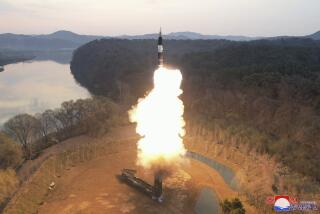Test of hypersonic X-51 aircraft ends prematurely
The second test of a U.S. Air Force experimental aircraft in Southern California ended prematurely this week just seconds after launch.
A video released Thursday showed a B-52 bomber launch the experimental X-51 WaveRider shortly before it crashed into the Pacific Ocean.
In the test that took place Monday, a B-52 took off from Edwards Air Force Base and flew to 50,000 feet near Point Mugu. Once there, the B-52 dropped the aircraft and it fell like a bomb for about four seconds before its booster rocket engine ignited and propelled the aircraft.
It was then supposed to separate from the rocket and speed across the sky, powered by an air-breathing combustion engine, but that didn’t happen. A momentary lapse in airflow to the engine caused a shutdown and the X-51 plunged into the ocean within the test range. The ocean landing was planned.
The 14-foot aircraft — which is designed to hit 4,000 mph — is being developed to give the Pentagon a new way to deliver a military strike anywhere around the globe within minutes.
“Obviously we’re disappointed and expected better results,” Charlie Brink, the Air Force X-51 program manager, said in a statement. “But we are very pleased with the data collected on this flight.”
Engineers are reviewing the large amount of telemetry data collected during the test flight to identify the cause of the problem, the Air Force said.
Developing an engine that can reach and maintain those speeds hasn’t been easy. For decades, the development of the hypersonic engine has been fraught with setbacks. “Hypersonic” refers to the speed of an aircraft blasting through the air at five times the speed of sound or more.
Engineers who developed the X-51 at Boeing Co.’s Phantom Works research center in Huntington Beach and Pratt & Whitney Rocketdyne in Canoga Park thought they were on the right track in May 2010 when the X-51 made its first flight for two minutes from Edwards Air Force Base.
Monday’s test flight was nearly three months late. The failure demonstrated that there is much work to be done in perfecting the technology. The next flight of the X-51 is tentatively scheduled for this fall, the Air Force said.
“We will continue to examine the data to learn even more about this new technology,” Brink said. “Every time we test this new and exciting technology, we get that much closer to success.”







